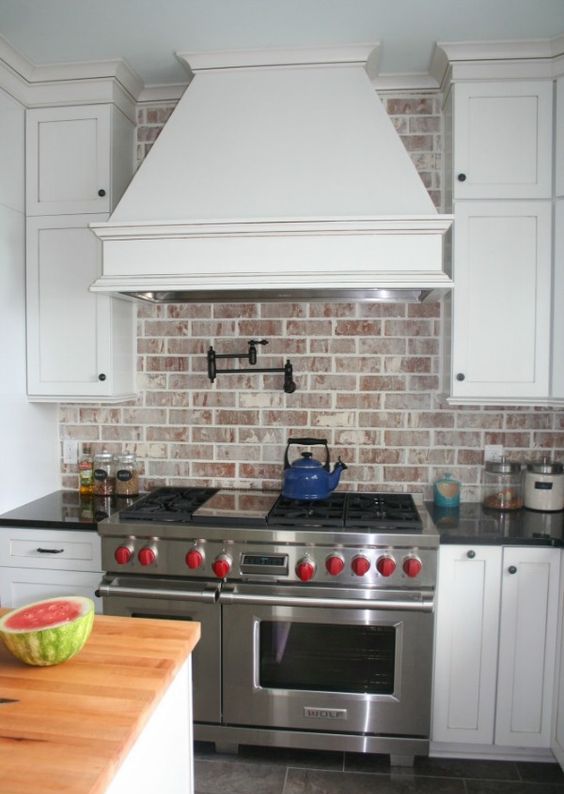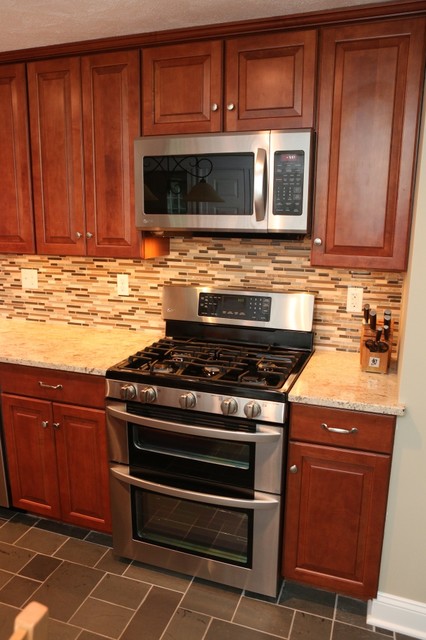When it comes to designing a traditional kitchen, the backsplash is a key element that can set the tone for the entire space. A traditional backsplash often features classic materials and designs that have stood the test of time. One of the most popular choices is subway tile, known for its clean lines and versatility. The standard 3×6-inch white subway tile is a staple in traditional kitchens, offering a timeless appeal that works well with various color schemes and cabinet styles. The simplicity of subway tiles also allows for creative variations in patterns, such as herringbone or vertical stacking, adding a subtle twist to the classic design.
Another popular material for traditional kitchen backsplashes is natural stone. Materials like marble, granite, and travertine bring a touch of luxury and elegance to the kitchen. Marble, with its distinctive veining and soft color palette, is particularly favored in traditional kitchens. It adds a sense of refinement and pairs beautifully with both dark and light cabinetry. While marble requires regular maintenance to prevent staining, its aesthetic appeal often outweighs the upkeep. Granite and travertine offer more durability and come in a range of earthy tones that complement traditional design themes.

For those who prefer a more ornate look, decorative tiles are an excellent option for a traditional kitchen backsplash. Hand-painted tiles, with their intricate patterns and vibrant colors, can serve as a focal point behind the stove or sink. These tiles often feature floral motifs, geometric patterns, or historical designs that reflect the heritage of traditional kitchen styles. They add a touch of artistry and craftsmanship to the kitchen, making it feel warm and inviting.
Mosaic tiles are another elegant choice for a traditional backsplash. These tiles come in various materials, including glass, ceramic, and stone, and can be arranged in intricate patterns or simple designs. The small size of mosaic tiles allows for creative expression, and they can be used to create a border or an accent wall that adds depth and texture to the kitchen. In a traditional kitchen, mosaics often feature neutral tones or classic patterns, ensuring they complement the overall design without overpowering the space.

Brick is a unique option for those looking to add rustic charm to a traditional kitchen backsplash. Exposed brick brings a sense of warmth and character, creating a cozy, lived-in feel. While real brick can be heavy and challenging to install, brick veneer provides a lighter, more manageable alternative that still offers the same aesthetic. This type of backsplash works particularly well in kitchens with farmhouse or cottage-style influences, where the emphasis is on comfort and timeless appeal.
Tin tiles are a distinctive choice for traditional backsplashes, harking back to early 20th-century design. These tiles often feature embossed patterns that add texture and visual interest to the kitchen. Available in various metallic finishes, tin tiles can be used to create a vintage look or add a touch of industrial flair. They are also durable and easy to clean, making them a practical choice for a busy kitchen. When paired with traditional cabinetry and vintage-inspired fixtures, tin tiles create a cohesive and charming kitchen environment.

Another timeless option is the use of beadboard as a backsplash. Beadboard, typically made of wood or MDF, features narrow, vertical planks with a bead-like detail along the seams. This material adds a cottage-style charm to the kitchen, especially when painted in classic white or soft pastels. Beadboard is a versatile choice that works well with various traditional kitchen styles, from country to coastal. It also offers a cost-effective alternative to more expensive materials like tile or stone.
If you’re aiming for a more formal traditional kitchen, consider a backsplash made of polished marble or granite slabs. Unlike tiles, which have grout lines that can interrupt the visual flow, slab backsplashes provide a seamless, continuous surface. This creates a more elegant and sophisticated look, ideal for traditional kitchens that lean towards the luxurious end of the design spectrum. The natural veining and patterns in marble and granite add a sense of movement and depth, making the backsplash a standout feature in the kitchen.
For a truly classic look, consider a backsplash made of terracotta tiles. Terracotta, with its warm, earthy tones, adds a rustic yet refined touch to traditional kitchens. These tiles can be left in their natural state or glazed for a more polished appearance. Terracotta pairs well with wooden cabinetry and wrought iron fixtures, creating a kitchen that feels grounded and connected to traditional European influences. The natural variation in terracotta tiles adds to their charm, ensuring that each backsplash is unique.
Ceramic tiles are another traditional favorite for kitchen backsplashes. They come in an array of colors, shapes, and sizes, allowing for endless customization. In a traditional kitchen, ceramic tiles are often arranged in classic patterns like basketweave, diamond, or checkerboard. The gloss finish of ceramic tiles adds a subtle sheen to the kitchen, reflecting light and making the space feel brighter. These tiles are also easy to clean, making them a practical choice for areas prone to splashes and spills.

If you’re looking for a backsplash that adds warmth and texture, consider using wood. While wood backsplashes are less common, they can be a beautiful addition to traditional kitchens, especially when treated to withstand moisture. Reclaimed wood, in particular, offers a rustic charm that adds character to the kitchen. Wood backsplashes pair well with natural stone countertops and traditional cabinetry, creating a cohesive and inviting space. However, it’s important to seal the wood properly to protect it from water damage.
Another traditional backsplash idea is the use of mirror tiles. While this might seem unconventional, mirror tiles can add a touch of glamour to a traditional kitchen. They reflect light, making the kitchen appear larger and brighter. When used sparingly, such as in a small accent area or behind the stove, mirror tiles can create a striking visual effect without overwhelming the traditional design. Paired with dark cabinetry and brass fixtures, mirror tiles can elevate the kitchen’s aesthetic to a new level of sophistication.
If you prefer a more subdued look, consider a backsplash made of limestone or sandstone. These natural stones offer a soft, earthy color palette that blends seamlessly with traditional kitchen designs. Limestone and sandstone have a matte finish, which adds a subtle texture to the backsplash. These materials are perfect for creating a serene, understated kitchen that exudes traditional elegance. While they require some maintenance to prevent staining, the unique beauty of these stones is well worth the effort.
Last, don’t overlook the classic appeal of a simple painted backsplash. While not as durable as tile or stone, a painted backsplash can be a cost-effective and easily changeable option for a traditional kitchen. Choose a high-quality, moisture-resistant paint in a color that complements your cabinetry and countertops. For added durability, consider installing a clear glass panel over the painted area. This approach allows you to enjoy the look of a traditional painted backsplash while protecting it from splashes and stains.

Common Mistakes to Avoid:
One common mistake when choosing a traditional kitchen backsplash is not considering the overall color scheme and style of the kitchen. A backsplash should complement the cabinets, countertops, and flooring, not compete with them.
Another mistake is choosing a backsplash material that is difficult to maintain. For example, while marble is beautiful, it requires regular sealing and care to prevent staining. It’s important to balance aesthetics with practicality, especially in a kitchen that sees a lot of use.
Another pitfall is overcomplicating the design with too many patterns or colors, which can make the space feel busy rather than cohesive. Lastly, not considering the long-term appeal of the backsplash can lead to regrets. While trendy designs may be tempting, it’s important to choose a backsplash that will stand the test of time and not look dated in a few years.

What is the best material for a traditional kitchen backsplash?
The best material for a traditional kitchen backsplash depends on your style preferences and maintenance tolerance. Subway tiles are a classic choice, offering a clean, timeless look. Natural stones like marble and granite add luxury and elegance but require more maintenance. Ceramic tiles are versatile and easy to clean, making them a practical choice for busy kitchens.
Can I mix different materials for my traditional kitchen backsplash?
Yes, mixing different materials can add depth and interest to a traditional kitchen backsplash. For example, you can use subway tiles as the primary material and incorporate a mosaic tile accent or a natural stone border. The key is to ensure that the materials complement each other and fit within the overall design theme of your kitchen.
How do I maintain a marble backsplash in a traditional kitchen?
Maintaining a marble backsplash requires regular sealing to prevent stains and etching from acidic substances. It’s important to clean spills immediately and use a pH-neutral cleaner to avoid damaging the surface. While marble is more high-maintenance than other materials, its timeless beauty can be worth the extra care.

Are there budget-friendly options for a traditional kitchen backsplash?
Yes, there are budget-friendly options for a traditional kitchen backsplash. Ceramic tiles are affordable and come in a wide range of styles that can mimic more expensive materials. Beadboard is another cost-effective option that adds a charming, traditional look. For those who prefer natural stone, consider using a smaller amount as an accent rather than covering the entire backsplash.
Can I install a traditional backsplash myself, or should I hire a professional?
Installing a traditional backsplash can be a DIY project if you have basic handyman skills and the right tools. Subway tiles and ceramic tiles are relatively straightforward to install. However, more complex materials like natural stone or intricate mosaic patterns might require professional installation to ensure a flawless finish. It’s important to assess your skills and the complexity of the project before deciding.
What colors are best for a traditional kitchen backsplash?
Neutral colors like white, beige, cream, and soft gray are ideal for a traditional kitchen backsplash. These colors create a timeless look that can easily be updated with different accents. For a more vibrant touch, consider incorporating soft blues, greens, or warm terracotta tones. The key is to choose colors that complement the overall design and color scheme of your kitchen.

Tile Splashback Ideas

Share your backsplash pics for a good cause!

HOME DECOR and DESIGN: EXPLORING THE KITCHEN BACKSPLASH

Related Posts:
- Kitchen Backsplash Tile Edge
- Kitchen Cooktop Backsplash
- How To Regrout Kitchen Backsplash
- Choosing Beautiful Kitchen Backsplash Tiles
- Kitchen Backsplash Ireland
- Retro Kitchen Backsplash
- Beige Backsplash Kitchen
- Kitchen Backsplash Ideas With White Cabinets Subway Tiles
- Coastal Kitchen Backsplash Tile
- Kitchen Backsplash Ideas Pictures Glass